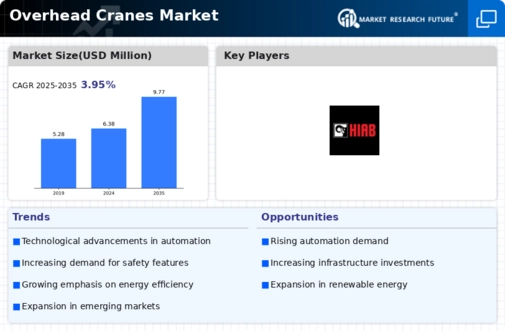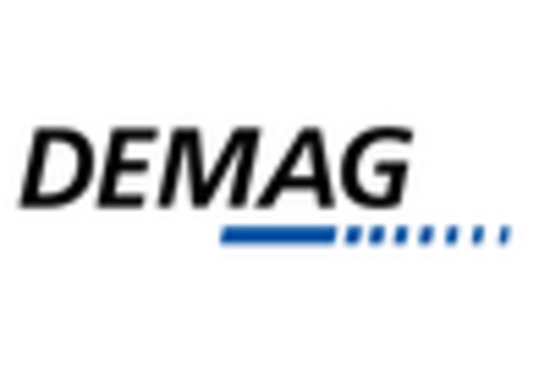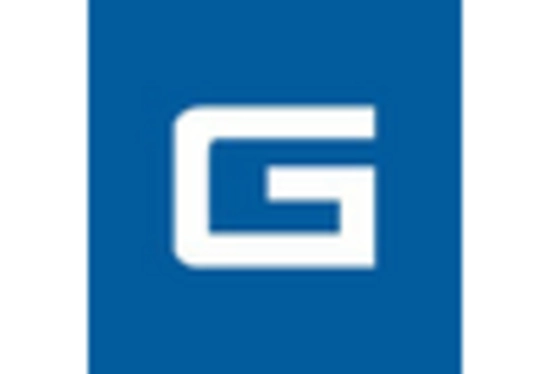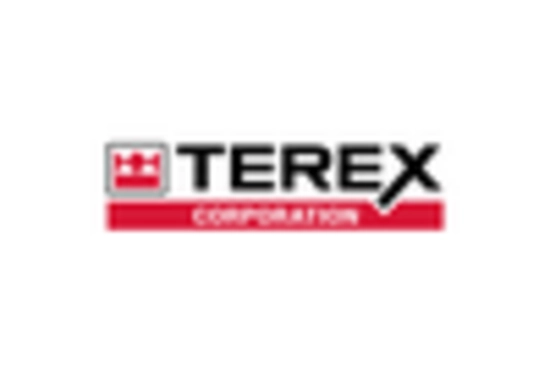Market Trends
Introduction
Towards 2024, the Overhead Cranes Market is expected to be influenced by a host of macro-economic factors, such as rapid technological developments, changing regulatory frameworks, and changing customer behavior. In the near future, innovations in automation and Internet of Things (IoT) integration are expected to enhance operational efficiency and safety. Meanwhile, the need for stringent regulations to ensure employee safety and environmentalism will force the manufacturers to adopt their offerings accordingly. In addition, the growing demand for customized lifting solutions is expected to reflect the consumers’ changing preferences for more versatile and efficient products. These trends are expected to have a significant impact on the product development and positioning strategies of the companies.
Top Trends
-
Increased Automation and Smart Technologies
The combination of the Internet of Things and artificial intelligence in the field of overhead cranes is transforming the industry. By reducing the cost of operations by up to 30 percent, automation is enabling greater efficiency. Predictive maintenance is becoming a standard feature of industry, which means that downtime is being reduced. Future developments may include fully-autonomous cranes, which would further optimize logistics and production processes. -
Sustainability and Eco-Friendly Solutions
The design of cranes is influenced by the development of the environment. Cargotec has introduced electric cranes that reduce the level of carbon dioxide emissions significantly. The industry’s data shows that energy consumption can be reduced by as much as 20 per cent with a sustainable approach. This development will lead more and more companies to seek green certification. This will also affect procurement decisions and operational strategies. -
Enhanced Safety Features
In the meantime, the cranes were being constantly improved with a view to reducing the risk of accidents. For example, the use of advanced safety systems by Terex Cranes has resulted in a drop in the accident rate of its cranes by 15 per cent. The authorities are also imposing these features, which could lead to a shift in the market standards and an increased demand for compliant equipment. -
Customization and Modular Designs
Custom-built cranes are in demand as a result of the growing needs of industry. Eilbeck Cranes has experienced a 25 per cent increase in orders for special equipment. This trend gives the customer more flexibility and allows him to optimize his production. Future developments may lead to a shift towards a more modular concept, which can easily be adapted or extended. -
Digital Twin Technology
The use of digital twins in the sphere of cranes is gaining ground. They enable the real-time monitoring and simulation of crane operations. The digital twin is used to increase efficiency in the field of crane operations. According to research, the digital twin can increase the efficiency of maintenance by up to 40 percent, which in turn can lead to a reduction in costs. As this technology develops, it may become the standard in the field of crane operations. -
Focus on Workforce Training and Development
And the need for skilled operators grows with the development of the technology. Columbus-Mackinnon is emphasizing training that has been shown to increase the efficiency of its operators by as much as 20 percent. The trend to develop skills highlights the importance of human resources development in retaining a competitive advantage. In the future, the company plans to develop virtual reality simulators to enhance the learning experience. -
Global Supply Chain Resilience
The Covid pandemic has demonstrated the need for a robust supply chain in the market for overhead cranes. EMH Inc has adapted by diversifying its suppliers, which has improved the operational stability of its business. It is estimated that companies with a robust supply chain can recover from disruptions to their operations 30% more quickly. This trend is likely to increase the investment in supply-chain technology and strategic alliances. -
Integration of Robotics
The use of robots is on the increase, and the cranes are being used in conjunction with them to increase their material handling capabilities. The Weihua Group has developed a system of using robots with cranes to increase their material handling capacity by as much as 25%. The use of cranes and robots together will change the way work is done, and it is expected that in the future the trend will be towards fully mechanized warehouses. -
Regulatory Compliance and Standards
The overhead crane market is being shaped by stricter regulations, with compliance becoming a critical issue for manufacturers. To meet these requirements, ABUS Crane System GmbH has extended its product range in line with the new standards. Regulatory compliance can result in higher operating costs, but it also ensures greater safety and reliability, which are vital for long-term success. -
Emerging Markets and Global Expansion
Industrialization is a major force driving the market for overhead cranes in emerging economies. Companies are expanding their activities in the region of Asia-Pacific, where demand is booming. In the long run, it is estimated that by 2025 the share of cranes sold in these countries will rise to 40 percent. This trend may lead to greater competition and innovation as companies seek to capture more of the market.
Conclusion: Navigating the Overhead Cranes Landscape
In 2024 the overhead crane market is characterized by high competition and significant fragmentation, with both established and new players vying for market share. Region-wise, the growth in Asia-Pacific and North America is driven by industrial growth and public works projects. The competition is intense. In order to succeed, vendors need to strategically position themselves, e.g. by focusing on automation, IoT and the latest developments in artificial intelligence, to meet the ever-changing customer needs. Product development and compliance with new regulations will also be key to staying at the forefront. The companies that are able to integrate these capabilities successfully will not only differentiate themselves but also gain a competitive advantage in the rapidly changing market.









Leave a Comment